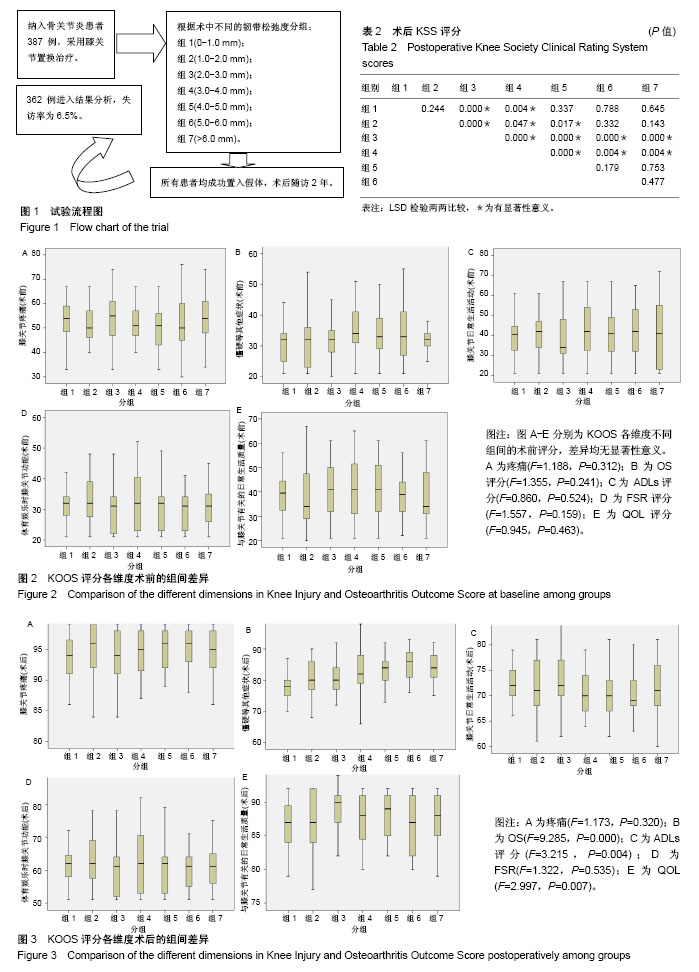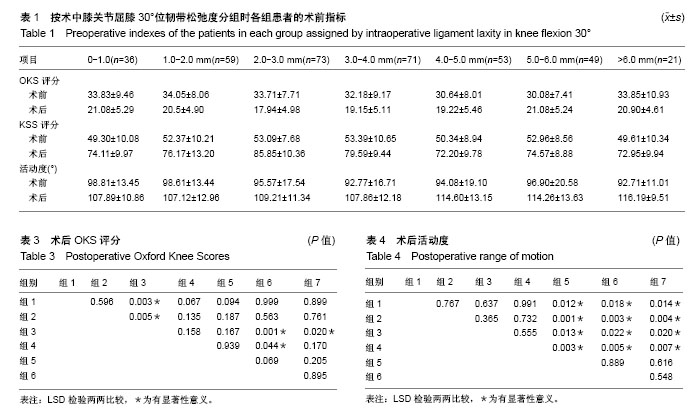| [1] Parratte S, Pagnano MW. Instability after total knee arthroplasty. J Bone Joint Surg Am. 2008;90:184. [2] Mihalko WM, Krackow KA. Flexion and extension gap balancing in revision total knee arthroplasty. Clin Orthop Relat Res. 2006;446: 121-126.[3] Takeda M, Ishii Y, Noguchi H, et al. Changes in varus-valgus laxity after total knee arthroplasty over time. Knee Surg Sports Traumatol Arthrosc. 2012;20:1988-1993.[4] Matsumoto T, Muratsu H, Tsumura N, et al. Soft tissue balance measurement in posterior- stabilized total knee arthroplasty with a navigation system. J Arthroplasty. 2009;24:358-364. [5] Warren PJ, Olanlokun TK, Cobb AG, et al. Laxity and function in knee replacement. Clin Orthop Relat Res. 1994;305:200. [6] Edwards E, Miller J, Chan KH. The effect of post-operative collateral ligament laxity ?in total knee arthroplasty. Clin Orthop Relat Res. 1988;236:44. [7] Paxton EW, Furnes O, Namba RS, et al. Comparison of the Norwegian knee arthroplasty register and a United States arthroplasty registry. J Bone Joint Surg(Am). 2011;93(Suppl 3):20-30.[8] Asano H, Muneta T, Sekiya I.Soft tissue tension in extension in total knee arthroplasty affects postoperative knee extension and stability. Knee Surg Sports Traumatol Arthrosc. 2008;16:999-1003.[9] Kuster MS, Bitschnau B, Votruba T. Influence of collateral ligament laxity on patient satisfaction after total knee arthro- plasty: a comparative bilateral study. Arch OrthopTrauma Surg. 2004;124: 415-417. [10] Mihalko WM, Whiteside LA, Krackow KA. Comparison of ligament-balancing techniques during total knee arthroplasty. J Bone Joint Surg(Am). 2003;85-A(Suppl 4):132-135. [11] Whiteside LA. Selective ligament release in total knee arthroplasty of the knee in valgus. Clin Orthop Relat Res. 1999;367:130-140.[12] Whiteside LA, Saeki K, Mihalko WM. Functional medial ligament balancing in total knee arthroplasty. Clin Orthop Relat Res. 2000; 380:45–57.[13] Collins NJ, Roos EM. Patient-reported outcomes for total hip and knee arthroplasty: commonly used instruments and attributes of a ‘‘good’’ measure. Clin Geriatr Med. 2012;28:367-394.[14] Roos EM, Lohmander LS. The Knee injury and Osteoar- thritis Outcome Score (KOOS): from joint injury to osteoarthritis. Health Qual Life Outcomes. 2003;1:64.[15] Jenny JY, Louis P, Diesinger Y . High activity arthroplasty score has a lower ceiling effect than standard scores after knee arthroplasty. J Arthroplasty.2014;29:719-721. [16] Vince KG, Abdeen A, Sugimori T. The unstable total knee arthroplasty: causes and?cures. J Arthroplasty. 2006;21(4 Suppl. 1):44. [17] Kim J, Nelson CL, Lotke PA. Stiffness after total knee arthroplasty. Prevalence of the complication and outcomes of revision. J Bone Joint Surg(Am).2004;86:1479.[18] Seah RB, Pang HN, Lo NN, et al.Evaluation of the relationship between anteroposterior translation of a posterior cruciate ligament-retaining total knee replacement and functional outcome. J Bone Joint Surg(Br). 2012;94:1362-1365.[19] Heesterbeek PJ, Verdonschot N, Wymenga AB.In vivo knee laxity in flexion and extension: a radiographic study in 30 older healthy subjects. Knee. 2008;15:45-49.[20] Bellemans J, Vandenneucker H, Van LJ, et al. A new surgical technique for medial collateral ligament balancing: multiple needle puncturing. J Arthroplasty. 2010;25:1151-1156.[21] Aunan E, Kibsgard T, Clarke-Jenssen J, et al. A new method to measure ligament balancing in total knee arthroplasty: laxity measurements in 100 knees. Arch Orthop Trauma Surg. 2012;132: 1173-1181.[22] Whitehouse SL, Blom AW, Taylor AH, et al. The Oxford Knee Score: problems and pitfalls. Knee. 2005;12(4): 287.[23] Kleeblad LJ, Borus TA, Coon TM, et al. Midterm survivorship and patient satisfaction of robotic-arm-assisted medial unicompartmental knee arthroplasty: A Multicenter Study. J Arthroplasty. 2018; S0883-5403(18):30074-30083.[24] Park BJ, Cho HM, An KY, et al. Acute arterial occlusion following primary total knee arthroplasty. Knee Surg Relat Res. 2018;30(1): 84-88.[25] Malik AT, Azmat SK, Ali A, et al. Seasonal influence on postoperative complications after total knee arthroplasty. Knee Surg Relat Res. 2018;30(1):42-49.[26] Palsis JA, Brehmer TS, Pellegrini VD, et al. The cost of joint replacement: comparing two approaches to evaluating costs of total hip and knee arthroplasty. J Bone Joint Surg Am. 2018;100(4): 326-333.[27] Namba RS, Inacio MCS, Pratt NL, et al. Persistent opioid use following total knee arthroplasty: a signal for close surveillance. J Arthroplasty. 2018;33(2):331-336.[28] Wilson CJ, Theodoulou A, Damarell RA, et al. Knee instability as the primary cause of failure following Total Knee Arthroplasty (TKA): A systematic review on the patient, surgical and implant characteristics of revised TKA patients. Knee. 2017;24(6):1271-1281.[29] Lim JBT, Chong HC, Pang HN, et al. Revision total knee arthroplasty for failed high tibial osteotomy and unicompartmental knee arthroplasty have similar patient-reported outcome measures in a two-year follow-up study. Bone Joint J. 2017;99-B(10):1329-1334.[30] Cancienne JM, Granadillo VA, Patel KJ, et al. Risk factors for repeat debridement, spacer retention, amputation, arthrodesis, and mortality after removal of an infected total knee arthroplasty with spacer placement. J Arthroplasty. 2018;33(2):515-520.[31] Koh YG, Son J, Kwon SK,et al. Preservation of kinematics with posterior cruciate-, bicruciate- and patient-specific bicruciate-retaining prostheses in total knee arthroplasty by using computational simulation with normal knee model. Bone Joint Res. 2017;6(9):557-565. |
.jpg)


.jpg)